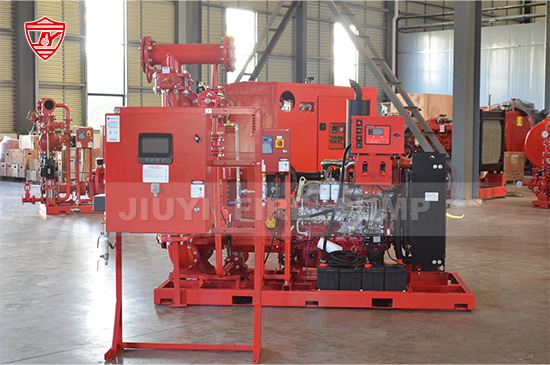Diesel engine fire pumps are critical components of fire protection systems, ensuring reliable water supply during emergencies. If a fire breaks out, a malfunctioning fire pump could lead to catastrophic losses. Regular and proper maintenance is not only essential for system performance but also required for compliance with NFPA 20 and local fire safety regulations.
In this article, we will cover everything you need to know about effectively maintaining a diesel engine fire pump — including inspection routines, testing procedures, preventive measures, and troubleshooting tips. Following these guidelines will help you extend equipment life, reduce downtime, and ensure maximum reliability.

A diesel engine fire pump is designed to operate under extreme conditions, but without proper maintenance, performance can degrade over time. Poorly maintained pumps may suffer from decreased water pressure, slow startup times, or complete system failure.
Ensures system reliability: A well-maintained pump responds instantly during emergencies.
Extends equipment lifespan: Prevents premature wear of critical components.
Reduces costly repairs: Early detection of issues avoids expensive breakdowns.
Ensures regulatory compliance: Meets NFPA 20 and insurance requirements.
Improves safety: Protects people, property, and business continuity.
The National Fire Protection Association (NFPA) Standard 20 provides detailed guidelines on diesel engine fire pump installation, testing, and maintenance. According to NFPA, routine inspections and performance tests must be carried out to ensure the fire pump is always in ready-to-use condition.
Weekly: Pump inspection and no-flow test
Monthly: Diesel engine battery check, fuel system inspection
Quarterly: Full-flow performance testing
Annually: Comprehensive system evaluation, calibration, and cleaning
Following NFPA’s recommended schedule will keep your diesel fire pump compliant and operational.

Effective maintenance involves more than just checking the engine. A diesel engine fire pump is a complex system with multiple components that must work together seamlessly. Below are the critical areas to inspect and maintain.
Check oil levels and replace oil according to manufacturer recommendations.
Inspect fuel filters and replace them regularly to prevent clogs.
Examine the air intake system to ensure unobstructed airflow.
Test the battery voltage and charging system for reliable starts.
Check coolant levels and condition to avoid overheating.
Inspect the pump casing for cracks, corrosion, or leaks.
Ensure pump shaft alignment to prevent premature wear.
Lubricate bearings and couplings to minimize friction.
Check impeller clearance and remove any obstructions.
Keep the diesel fuel tank at least 2/3 full at all times.
Drain water and sediment from fuel tanks and filters regularly.
Replace fuel filters as part of scheduled maintenance.
Test battery voltage and electrolyte levels weekly.
Ensure battery terminals are free from corrosion.
Inspect charging alternators to guarantee consistent power supply.
Check exhaust systems for leaks, blockages, or cracks.
Inspect cooling systems, including radiators, hoses, and fans.
Clean heat exchangers to maintain optimal operating temperatures.
Consistency is key in diesel engine fire pump maintenance. Here’s a simplified checklist based on NFPA 20 recommendations:
Conduct a visual inspection of the entire pump system.
Check oil, coolant, and fuel levels.
Perform a 10-minute no-flow pump test.
Record engine parameters such as RPM, oil pressure, and temperature.
Inspect control panels and alarms.
Test batteries and charging systems.
Check diesel fuel for contamination or water buildup.
Inspect the air intake and exhaust systems.
Verify operation of automatic start controls.
At least once a year, a diesel engine fire pump should undergo a full-flow performance test to verify system capacity and reliability. This process involves measuring water flow, discharge pressure, and engine performance.
Run the pump under various load conditions.
Measure suction and discharge pressures.
Evaluate battery performance under load.
Inspect critical components for wear and tear.
Replace worn parts proactively to avoid future failures.
Annual testing should always be carried out by trained professionals to ensure accuracy and compliance.
Even with regular maintenance, diesel fire pumps can encounter operational issues. Understanding common problems and solutions can save valuable time during emergencies.
| Issue | Possible Cause | Solution |
|---|---|---|
| Pump fails to start | Weak battery, faulty starter, fuel blockage | Check battery voltage, starter wiring, and fuel lines |
| Low discharge pressure | Clogged impeller, air leaks, valve malfunction | Clean impeller, check valves, seal leaks |
| Overheating engine | Low coolant, blocked radiator, failed water pump | Refill coolant, clean radiator, replace faulty pump |
| Excessive vibration | Misalignment, damaged bearings | Realign shaft, replace bearings |
| Unusual engine noise | Loose components, worn parts | Tighten bolts, replace defective parts |
To maximize the reliability and lifespan of your diesel fire pump, adopt the following best practices:
Follow manufacturer guidelines: Always refer to OEM manuals for servicing schedules.
Maintain detailed logs: Keep records of inspections, tests, and repairs.
Use genuine spare parts: Avoid substandard components that can reduce performance.
Train maintenance personnel: Ensure your team understands fire pump systems thoroughly.
Schedule professional audits: Hire certified technicians for annual inspections.
While basic maintenance can be handled in-house, collaborating with fire pump specialists ensures your system operates at peak efficiency. As a leading manufacturer of diesel engine fire pumps, we provide customized maintenance solutions, technical support, and certified spare parts to keep your system compliant and reliable.
Regular servicing not only protects your investment but also guarantees your fire protection system will respond effectively when needed most.

Effective diesel engine fire pump maintenance is more than a safety measure — it’s a business necessity. By following NFPA 20 guidelines, performing regular inspections, and working with experienced professionals, you can ensure your fire pump operates reliably for years to come.
A proactive maintenance strategy reduces downtime, avoids costly breakdowns, and, most importantly, safeguards lives and property.